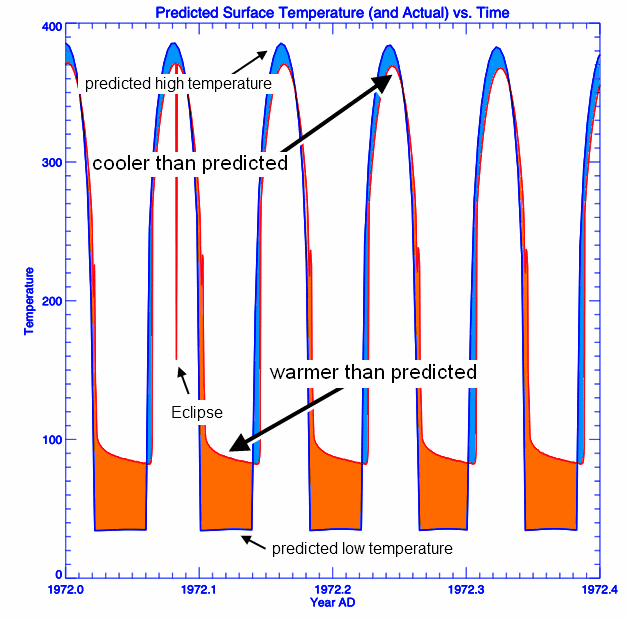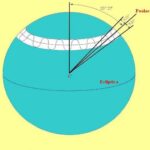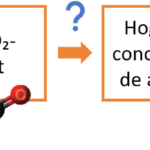Mijn mooiste verkiezingswens is dat een nieuw kabinet het ministerie van VROM straks onmiddelijk opdracht geeft een klein kenniscentrum (of een bijzonder leerstoel) te stichten dan wel te subsidiëren, dat zich exclusief gaat bezighouden met de fundamentele werking van CO2 en de aardse broeikas. Met de studies van Noor van Andel en Arthur Rörsch is zo iets eigenlijk al aan de gang. Een andere Nederlandse scepticus die zich al jaren intensief met de fysica achter de temperatuur van de aarde bezighoudt is de chemicus Hans Schreuder met zijn recent gereactiveerde website ilovemycarbondioxide.com.
Oude koeien
Waarschuwing: wat nu volgt is niet peer reviewed. Schreuder heeft me wel persoonlijk toevertrouwd dat wegen naar de journals worden gezocht. Daarmee valt het onderstaande voor wat het waard is (blogserie wordt vervolgd) onder de post-normale wetenschap waarbij de blogosfeer als correctie kan werken op een in dogmatiek en oude koeien verstrikt geraakte wetenschap. Scott Dennings presentatie op ICCC4 was één grote oude koe, weliswaar enthousiast en aanstekelijk gebracht, maar toch.
Nu dan eindelijk de boter bij de vis: staar eerst eens een minuutje naar bovenstaande grafiek, download dan de pdf Greenhouse_Effect_on_the_Moon en lees dit. Neem dan en passant ook recente blogs over de fysica van het klimaat op Venus mee (hier, hier en hier) en Stephen Wilde’s theorie van het Hot Water Bottle Effect zoals enige tijd geleden gepost op ClimateRealists.com. Deze bundel moet genoeg zijn om definitief te genezen van Kees Vendrik’s verzekering dat het begrijpen van het broeikaseffect niet moeilijker is dan havo 5. Ga nu eens helemaal nieuw en fris over dat vermaledijde broeikaseffect denken (zie ook mijn reactie hieronder)!
Hieronder nog het Engelstalige bijschrift waarmee Hans Schreuder de pdf over het “broeikaseffect” op de maan in zijn mailing introduceerde.
Yes, that’s right, there is a “greenhouse effect” on our moon and it’s even greater than here on earth.
The idea of an atmospheric “greenhouse effect” was invented to justify why earth is supposedly “warmer than it should be” if there was no atmosphere.
As we now know from NASA’s research, even our moon is “warmer than it should be”, by a whopping 40 degrees C where earth is a mere 33 degrees “warmer”.
“We’ve been told that the earth’s surface is quite a bit warmer than calculations predict. Theory has it that heat-trapping “greenhouse gases” account for a 33° Celsius disparity. But it turns out that our airless moon is also quite a bit warmer than predicted. Might something be wrong with the prediction method itself, then? It’s a natural question to ask, so let’s look into it.”
“The Earth is not “unusually” warm. It is the application of the predictive equation that is faulty. The ability of common substances to store heat makes a mockery of blackbody estimates. The belief that radiating trace gases explain why earth’s surface temperature deviates from a simple mathematical formula is based on deeply erroneous assumptions about theoretical vs. real bodies.”
The justification for calculating the temperature that earth “should be at” is shown to be incorrect. It’s based on a formula that is used to convert irradiation levels to temperature and vice versa, based on a blackbody. Earth nor any planet that we know of behaves like a blackbody. All planets literally absorb some of the solar heat during daytime and emit some of that during nighttime. Our moon is the perfect example of that: it has no atmosphere and receives as good as the same level of irradiation as earth does.
Our atmosphere is shown to act as a coolant during the day and a retarder of cooling during the nighttime; the amount of retardation depending on the relative humidity of the atmosphere, which in turn determines the total heat content of a given volume of the atmosphere.
But at all times our atmosphere acts as a conveyor of heat, never a creator of heat.
This essay puts it into perspective.
It does not matter what our atmosphere is made of, it is the surface, including the oceans, that makes it “warmer than it should be”.
And yes, seeing that carbon dioxide is actually a good radiator, the only possible effect it can have on the atmosphere is to increase its cooling efficiency; it can’t possibly make the atmosphere warmer. Adding a coolant gas to a coolant atmosphere, what else could you expect?
Please spread this paper far and wide, as it clearly proves by means of direct observations that no atmosphere is needed to be “warmer than calculated”.
Nothing to do with CO2 after all.
Hans Schreuder
www.ilovemycarbondioxide.com







Is deze meneer geniaal of gek?
"But at all times our atmosphere acts as a conveyor of heat, never a creator of heat."
Volgens mij wordt dat nooit door serieuze klimaatwetenschappers beweerd.
en dan deze:
"It does not matter what our atmosphere is made of, it is the surface, including the oceans, that makes it “warmer than it should be”.
And yes, seeing that carbon dioxide is actually a good radiator, the only possible effect it can have on the atmosphere is to increase its cooling efficiency; it can’t possibly make the atmosphere warmer. Adding a coolant gas to a coolant atmosphere, what else could you expect?"
Als het niet uitmaakt waar onze atmosfeer van gemaakt is, maken de eigenschappen van CO2 dus ook niet uit. Maar toch vindt de schrijver het nodig om van CO2 te melden dat het een goede radiator is. Kennelijk doet de atmosfeer dus toch wat. Bovendien: voordat CO2 goed warmte kan uitstralen, moet het die warmte eerst in zich opnemen. Het 'verkoelende effect' van CO2 treedt dus alleen maar op voor zover de CO2 verder was opgewarmd dan de andere gassen waaruit onze atmosfeer bestaat. Tenminste, dat meen ik me te herinneren uit mijn weggezakte middelbare school-kennis van natuurkunde.
Slimmere mensen op deze site, verlos mij van mijn twijfel: heb ik het bij het rechte eind en is dhr. Schreuder off his rocker? Wie legt het me uit?
Beste Paul,
Hans Schreuder is een hoogintelligente ingenieur die weet waarover hij het heeft. Zijn benadering is wat eenzijdig maar in wezen heeft hij gelijk.
Roy Spencer legt dit ook helder uit in zijn boek Climate Confusion. Het broeikaseffect is volgens hem het effect waarbij het aardoppervlak in afwezigheid van convectie (want dat is wat een broeikas doet; de convectie wegnemen) overdag 80 graden heet zou worden. De atmosfeer koelt het aardoppervlak en inderdaad zal het toevoegen van IR-actieve gassen en waterdamp er alleen maar voor zorgen dat de koeling (die in dat geval gelijktijdig is met de opwarming door de zon) beter en sneller verloopt.
's Nachts zal het beetje extra CO2 zorgen dat de atmosfeer en het aardoppervlak iets minder pijlsnel richting absolute nulpunt afkoelt. De oceanen en de wolken zijn natuurlijk de echt effectieve rem op deze maanachtige ultra-afkoeling. CO2 is een zandkorreltje in deze machinerie.
Het is in ieder geval bekend dat CO2 boven ijskoude oppervlakten zoals antarctica alleen maar voor meer uitstraling en dus extra afkoeling zorgt (de bovenlucht is daar warmer dan het aardoppervlak door de permanente inversie).
Verder moet je de aarde zien als een bol waarin nooit iets in evenwicht is… ieder punt heeft ofwel een stralingsoverschot of een stralingstekort… CO2 heeft een zeer kleine invloed die op iedere plek op ieder moment ook weer totaal anders is.
Het netto overall effect van ietsje meer CO2 (zeker als we de biosfeer meenemen in het verhaal) is eigenlijk per definitie alleen maar een kwestie van afwachten. Dat kan de komende jaren bij een afzwakkende zon terwijl CO2 blijft stijgen. Over 5 jaar weten we meer.
De vraag wat doet een verdubbeling van CO2 met de aardse temperatuur is net zo moeilijk te beantwoorden als de vraag: wat gebeurt er met de Nederlandse politiek als de kelners in alle restaurants en cafés in 10% van de kopjes koffie stiekum een klontje suiker doen.
Waarschijnlijk doet het niets, mogelijk doet het iets maar zullen we nooit precies weten wat, heel heel misschien is er een merkbaar causaal herleidbaar effect, maar dat is alleen achteraf te kennen en fundamenteel niet te voorspellen.
Hajo, ik vind jouw gedachtengang een stuk beter te volgen dan die van Hans Schreuder. Zijn betoog, en het gelinkte artikel 'Greenhouse effect on the Moon?' beginnen beiden heel plausibel maar trekken zeer vreemde conclusies. 'De aarde en de maan zijn warmer dan ze zouden moeten zijn volgens een blackbody-berekening en daarom is het broeikaseffect niet waar.' Beide betogen gaan hier toch moedwillig voorbij aan het feit dat een blackbody puur een theoretische construct is die op zichzelf nooit een precieze indicatie kan opleveren van de temperatuur op een levensechte planeet?
Dhr. Schreuder mag zeer intelligent zijn en is ook vast heel aardig maar zijn verhaal overtuigt me gewoon niet, zie mijn eerdere opmerking. Nogmaals: ik accepteer direct een plausibele weerlegging van mijn interpretatie van zijn betoog. Ik kan het makkelijk mis hebben want ik mis nog te veel inhoudelijke kennis. Maar als ik Schreuder's bedoeling correct interpreteer, dan klopt het toch gewoon niet wat hij opschrijft?
Je compliment siert je zoals ook je hele stijl van vragen en reageren de laatste tijd (iha zie ik een positieve trend in de reacties).
Ik heb het artikel net van de verbanning naar de rechterkolom bevrijd en in de hoofdstroom geplaatst, waar ik een bundel publicaties geef die samen tenminste zullen oproepen tot ernstige twijfel aan een conventioneel simplistische statische eendimensionale weergave van de broeikaswerking.
Er is hier echt sprake van geleidelijke waarheidsvinding in de blogosfeer en dus niet een situatie van heeft Piet 100% gelijk of Jan. Het gaat erom dat je aan het denken wordt gezet en dat je mogelijk denkt "something is rotten in the state of Denmark".
Verder beveel ik Roy Spencer's Climate Confusion meer dan hartelijk aan.
Ah, dus ik zie dat de "skeptici" eigenlijk gewoon een alternatieve definitie hebben van het "broeikaseffect" en dan vervolgens aantonen dat dit tot andere dingen leidt dan wat door de "warmers" wordt verwacht.. ik snap niet hoe CO2 tot afkoeling van het aardoppervlak leidt, wie of wie kan me dit uitleggen? Er zijn wel atmosferische processen die het aardoppervlak afkoelen, maar dat is niet een onderdeel van het "broeikaseffect".
Ps: over 5 jaar weten we weinig meer gezien de grote jaarlijkse variabiliteit, pas over 30 jaar weten we meer.
Beste Arjan,
Je vraagt om een nadere uitleg (over de CO2 ‘koeling’ )maar die is niet zo makkelijk te geven zonder de tweede hoofdwet van de thermodynamica en daardoor vervalt men gemakkelijk in een vergelijkbaar te simpel model voor het broeikaseffect als dat de atmosfeer als een warme deken over het aardoppervlak ligt.
De gedachtegang dat verdere toeneming van CO2 een verkoelende werking kan hebben, in plaats van opwarmende, is ruwweg de volgende.
Nabij het oppervlak is de atmosfeer al vrijwel optisch dicht door de waterdampspanning die daar heerst. De onderste damplaag, zo’n 100 m dik, straalt daardoor al maximaal terug naar het oppervlak en is daarmede vrijwel in stralingsevenwicht. De volgende lagen van 100 m leveren steeds minder een bijdrage aan de terugstraling, maar steeds sterker aan de uitstraling naar het heelal. De bijdrage aan die uitstraling door waterdamp neemt snel af met de temperatuurgradiënt in de atmosfeer. Boven de eerste wolkenlaag op ca 3 km hoogte, komt nog maar weinig waterdamp voor, maar CO2 is en blijft een gas, vriest niet uit, verdeelt zich over de gehele atmosfeer, en gaat daardoor in de hogere luchtlagen een steeds sterkere bijdrage leveren aan de uitstraling naar het heelal.
Het broeikaseffect kan echter niet uitsluitend aan de stralingtransfer processen in de atmosfeer worden toegeschreven . De ‘klassieke’ klimatologie (van voor 1965) beschouwt die zelfs in het geheel niet bij de verklaring hoe de aarde zijn oppervlakte temperatuur ‘regelt’. Beperkt zich tot de waterhuishouding waaraan de energiehuishouding is gekoppeld.
Het wetenschappelijke probleem is nu dat deze twee processen, op een wereldschaal nog steeds niet voldoende degelijk kunnen worden beschreven, voor een planeet op 40 C aan de equator en – 60 C aan de polen. De belangrijkste drie krachten die op wereldschaal de oppervlaktetemperaturen binnen grenzen houden, zijn de oppervlaktetemperatuur zelf, die de verdamping stuurt, de wolkbedekking (50 %) die de energie-instraling van de zon regelt en ook in hoge mate de terugstraling naar het oppervlak, en de werking van de tweede hoofdwet aan de top van de troposfeer waar in dit gebied naar maximale entropieproductie wordt gestreefd.
Dus, enerzijds wordt er ‘geduwd’ aan het broeikaseffect aan het oppervlak, en anderzijds aan de top van de atmosfeer ‘getrokken'. Maar nogmaals, ook dit is een te simpele metafoor.
Noor van Andel vatte onlangs de controverse, naar aanleiding van de presentaties bij de Heartland conferentie als volgt samen: “Het begint steeds duidelijker te worden waar de IPCC-heren de mist in zijn gegaan. Foute conclusies uit ogenschijnlijke correlaties, verkeerd interpreteren van verbanden, omkeren van oorzaak en gevolg bij regressieberekeningen van meetresultaten. Hun beruchte eerste zeperd was de omdraaiing van CO2 / temperatuur gang in ijsboorkernen, maar daar is het niet bij gebleven.”
Vriendelijke groeten,
Arthur Rörsch
Volgens mij was emissiviteit gelijk aan absorptiviteit (in thermisch equilibrium), dus hoe kunnen hogere luchtlagen meer uitstralen naar het heelal maar minder naar het aardoppervlak? Deze redenering klopt fysisch niet, of ik begrijp u niet. De uitstraling is inderdaad afhankelijk van de temperatuur. Bij een verhoging van de CO2 concentratie op grote hoogte absorbeert deze laag thermische straling (van lagen met een hogere temperatuur eronder), en warmt dus op, en zend dus onder een hogere temperatuur thermische straling uit naar boven EN naar beneden. MAW, de hoogte van die optisch dikke laag verandert dus, waardoor de uitstraling vertraagd wordt en het dus opwarmt!!!
De opmerking dat in de klassieke klimaat fysica geen stralingsbalansen (gevolg van transfer..) worden gebruik is heel vreemd. De stralings imbalans tussen de polen en de evenaar is de "driver" van het verminderen van de temperatuurgradient tussen de polen en de de evenaar (De Hadley circulatie, en de indirect gedreven Ferrel circulatie). Dit is heel eenvoudige en basale fysica. In de meest eenvoudige conceptuele modellen wordt waterdamp (latent heat release, diabatic heating) dan ook gewoon weggelaten. (in echte klimaatmodellen natuurlijk niet!) Moderne klimaatmodellen zijn heel goed in staat om met de bekende fysische processen bijzonder precies (lokale afwijkingen van slechts ~ enkele graden, zie ook http://scienceofdoom.com/2010/02/27/models-on-and… , deze (niet alarmistische) website bevat meer goede fysische uitleg!). Ik zal de rest nog eens overleggen met wat atmosferische fysici die ik ken, mits ik daar nog de kans voor krijg.
Beste Arjan(2)
Akkoord, wat betreft de basisfysica dat elke (virtuele) laag in de atmosfeer evenveel omhoog straalt als omlaag. Echter wat van elke laag op een bepaalde hoogte (bij een bepaalde temperatuur) in een semi-transparante atmosfeer het oppervlak bereikt, of naar het heelal gaat, is zeer verschillend. Kijken we van beneden naar boven dan is nabij het oppervlak over de eerste 100 meters de atmosfeer praktisch optisch dicht (althans voor de golflengten waarbij de broeikasgassen absorberen). Wat naar het oppervlak wordt teruggestraald is echter ook vrijwel uitsluitend uit die dunne laag afkomstig. Want kijken we van boven zo’n laag naar beneden dan is die voor die straling even ‘optisch’ dicht. Dus weinig straling vanuit zo’n hogere laag bereikt ook direct het oppervlak. Boven die hogere lagen wordt de optische dichtheid steeds geringer. Met het gevolg dat op de hoogte van de (virtuele) top van de atmosfeer de straling die richting heelal gaat, uit een veel grotere laag (gerekend in meters) afkomstig is.
Je schrijft: “De opmerking dat in de klassieke klimaat fysica geen stralingsbalansen (gevolg van transfer..) worden gebruik is heel vreemd “. Dat heb ik niet opgemerkt. Ik vond in een handboek anno 1955 zelfs al een mondiale stralingsbalans die kwa getallen nauwelijks afwijkt van de recent berekende (Khiel en Trenberth 1996) . Ik schreef: De ‘klassieke’ klimatologie (van voor 1965) beperkt zich bij de verklaring hoe de aarde zijn oppervlakte temperatuur ‘regelt’ tot de waterhuishouding waaraan de energiehuishouding is gekoppeld.
Het hier bovengenoemde ‘lagen model’ is uiteraard te simplistisch. Waar het om gaat is het effect van die huishouding op de oppervlaktetemperatuur, die warmte naar boven transporteert, waar de energieuitstraling naar het heelal plaats vindt.
Je schrijft: “De stralings imbalans tussen de polen en de evenaar is de “driver” van het verminderen van de temperatuurgradient tussen de polen en de de evenaar (De Hadley circulatie, en de indirect gedreven Ferrel circulatie). Dit is heel eenvoudige en basale fysica.” Mee eens, behalve met de laatste zin. Het beschrijven van gecombineerd stof- en energietransport bij turbulente stroming is, vrees ik, voor proces-ingenieurs nog steeds een worsteling.
Tenslottte schrijf je: “Ik zal de rest nog eens overleggen met wat atmosferische fysici die ik ken”. Ik ken er in Nederland eigenlijk maar twee, die denk ik enig inzicht in de complexe materie hebben: Van Delden in Utrecht en Van Andel in Almelo.
Arthur Rörsch
Gelukkig ken ik meer klimaatfysici die er een goed inzicht in hebben. Anyway, je stelt dat straling "van boven" niet door de optisch dichte laag heen komt. Volgens mij klopt dit niet. Het is wel zo dat de onderste lagen, omdat ze het warmst zijn het sterkst uitstralen (naar boven en naar beneden), maar als deze laag dat doet, en je voegt meer broeikasgassen toe, dan wordt er dus altijd meer van deze straling (naar boven) geabsorbeerd (bijvoorbeeld in een hogere laag). Deze laag warmt dus ook op, en stralen ook weer meer naar beneden (en naar boven), zodat er weer een evenwicht is in deze laag (bij hogere T). Deze "extra" straling naar onderen warmt alle lagen daaronder (indirect) op. Een toename van broeikasgassen "vertraagt" dus de warmteuitwisseling tussen het aardoppervlak en de atmosfeer. Als je echt wil weten hoe het zit, kijk anders eens op de website van de heer Van Delden. MvG, Arjan
Dit beantwoordt je vraag niet zie ik nu, waarschijnlijk heb ik deze niet goed begrepen. De atmosfeer is vrijwel optisch dicht (opaque) voor langgolvige straling trouwens. Bedoel je te zeggen, dat doordat de uitstralingslaag hoger komt te liggen, het oppervlak toeneemt, waardoor er dus netto meer uitstraling is? Ik ken dit skeptische argument, namelijk dat er processen zijn die de diepte van de atmosfeer beinvloeden, en dus de uitstraling. Is dit uw argument?
Scott Denning oude koeien?
Hij legt anders mooi de vinger op de zere plekken in het "skepticisme": Alsof emissiereductie per definitie tot totale ontwrichting vd economie zou lijden (alarmisme…?!?) en nog een aantal andere spiegels worden voorgehouden. Heel zinvol (voor wie er voor open staat).
Zie ook http://ourchangingclimate.wordpress.com/2010/05/2…
PS
Zonder broeikaseffect zou de aardse temperatuur ongeveer 30 graden kouder zijn dan zij is. Dat is nl de evenwichts "black body" temperatuur die de aarde zou hebben als alle IR die de aarde uitstraalt de atmosfeer ook daadwerkelijk zou verlaten. Gelukkig is dat niet zo, anders waren wij hier niet om het over het BKE te hebben.
Zie ook
http://chriscolose.wordpress.com/2010/02/18/green…
http://en.wikipedia.org/wiki/Black_body#Temperatu…
http://en.wikipedia.org/wiki/Greenhouse_effect
Beste Paul en Bart,
Als Hajo Smit mij om advies had gevraagd om aandacht aan Hans Schreuder te schenken, zo ik dat hebben ontraden. Ik twist al jaren met hem over zijn benaderingen. Ik vind dat hij verwarring sticht over de fysische grondslagen van het broeikaseffect die ook door de overgrote meerderheid van de klimaatsceptici worden aanvaard. In een volgende bijdrage zal ik uiteenzetten welke grondslagen, volgens Van Andel en mij niet mogen worden genegeerd, en waartoe dat dan leidt. En dit naar aanleiding van reportages over de Heartland conferentie in Chigaco, waar inderdaad veel manco’s aan de CO2 hypothese na voren werden gebracht, maar ook extreme sceptische opvattingen die mijns inziens onvoldoende hout snijden.
Maar nu eerst even dit.
Bart schrijft: “Zonder broeikaseffect zou de aardse temperatuur ongeveer 30 graden kouder zijn dan zij is. Dat is nl de evenwichts “black body” temperatuur die de aarde zou hebben als alle IR die de aarde uitstraalt de atmosfeer ook daadwerkelijk zou verlaten”
Die 30 graden ‘kouder’ is gebaseerd op wat men noemt de ice-bal theorie, die is gebaseerd op de al te simpele aanname dat men de van zon ontvangen straling over het hele aardoppervlak mag middelen, om tot een energie/ stralingsbalans te komen. Het is een gedachte experiment en niet meer.
De 30 graden kouder, gemiddeld, is een fictie. Omdat de aardas scheef staat, de aarde om zijn as en om de zon draait, wordt de regio (ook zonder broeikaseffect) rond de evenaar oververhit en een simpele berekening leert, tot bijna 100 C. Aan de polen echter, zou de temperatuur tot vrijwel het absolute nulpunt (in de poolnacht) naderen.
Het ontstaan van het wezen van het broeikaseffect zit hem in dit verschil. De temperatuur loopt aan de equator niet op tot 100 C, (maar tot gemiddeld 30 C) omdat de verdamping van het oceaanwater koelend werkt. De temperatuur aan de polen bereikt niet het absolute nulpunt maar blijft bij min 40-60 C hangen.
Aldus, het broeikaseffect, in samenwerking met de waterhuishouding, werkt zowel plaatselijk koelend, als plaatselijke warmend.
Als het nog niet duidelijk is, stuur ik gaarne mijn PP presentatie toe, of nodig jullie uit deze bij mijn thuis aan te horen. (tel. 071 5142328 voor een afspraak) .
Vriendelijke groeten,
Arthur Rörsch
Ik denk dat ik uw uitleg wel snap, maar volgens mij heeft die herverdeling van warmte niets te maken met het broeikas effect. (Wel met het feit dat we een atmosfeer hebben). Of is hier ook een "alternatieve" fysische verklaring voor?
Betreft reacties op waarnemingen van Wolters en Van Kasteren bij Heartland conferentie
Wat mij verwondert is, dat sommigen zich zo sterk blijven verzetten tegen de veronderstelling dat CO2 slechts een gering, of wellicht geen, of zelfs een negatieve invloed op het broeikaseffect kan hebben.
Waarschijnlijk is de oorzaak het vasthouden aan de simpele ‘aardse broeikas’ metafoor : CO2 is een broeikasgas, absorbeert infrarood (IR) , dat warmt de atmosfeer op, en daarmede het aardoppervlak. Dat is het HAVO 5 niveau waarop Wolters doelt.
Het effect op het aardoppervlak is echter niet het gevolg van absorptie van IR, maar van het feit dat een broeikasgas in de atmosfeer IR uitstraalt, en gedeeltelijk naar het aardoppervlak.
Het broeikaseffect is het gevolg van emissie vanuit de atmosfeer.
De belangrijkste veroorzaker van een broeikaseffect is de 50 % wolkbedenking, Het water en ijs in de wolken stralen gelijk het aardoppervlak IR uit over een breed spectrum. Het gevolg is een stralings interactie tussen deze twee elementen.
Daarnaast oefent het sterkst aanwezige broeikasgas, de waterdamp, (mondiaal gemiddeld 2 % in de atmosfeer) , een kleine invloed uit door in een beperkt deel van het IR spectrum naar het aardoppervlak terug te stralen. Theoretisch draagt CO2, (0.038 % in de atmosfeer) daar een klein beetje aan bij, temeer omdat het over een nog kleiner golflengtegebied straalt dan waterdamp.
Wat verwachten we nu van de toename van de CO2 concentratie in de atmosfeer, voor de toename van de terugstraling naar het aardoppervlak terwijl we weten dat de emissieband van CO2 al aanzienlijk overlapt met die van de waterdamp?
Mijn idee is, we kunnen er nog geen definitieve uitspraken over doen want het systeem dat het mondiale broeikaseffect stuurt, is zeer complex, wordt aangestuurd door weerverschijnselen die voortdurend de grote hoeveelheid warmte ontvangen aan de tropen, herdistribueren naar noordelijker en zuidelijker regionen, waar deze in overwegende mate naar het heelal wordt uitgestraald. Het wordt inmiddels zelfs theoretisch beredeneerd dat CO2 concentratie verhoging een koelend effect zal hebben, in plaats van een opwarmend, althans bij de concentratie die het thans al heeft bereikt.
Wie weet? CO2 dringt door tot de top van de atmosfeer en bevordert daar de warmte-uitstraling naar het heelal.
Binnenkort verschijnt in een ‘special issue’ van het opiniërende Britse blad Energy & Environment (midden juni) een reeks artikelen waarin de beschouwingen van de door Wolters genoemde Eschenbach en Miskolzci worden uitgewerkt en van commentaar worden voorzien. Deze zijn het resultaat van een intensieve, kritische discussie gedurende ruim een jaar, van enige tientallen lieden in de wereld die menen dat ze een beetje beginnen te begrijpen hoe de weer- of waterthermostaat de oppervlaktetemperatuur regelt.
Een correctie. Miskolzci is van origine geen Pool maar een Hongaar. Een toevoeging. Noor van Andel is een oud AKZO Nobel research directeur, thans expert op het gebied van de ‘glazen’ broeikas en in het bijzonder van de processen van de gecombineerde stof- en warmteoverdracht die bij de waterhuishouding in de atmosfeer van betekenis zijn. Hij bekritiseert en ondersteunt het werk van Eschenbach en Miskolzci met berekeningen waarvoor meer dan HAVO 5 kennis nodig is om ze te begrijpen.
Arthur Rörsch
Ligt dat nu aan mij of hebben anderen ook moeite met het lezen van de reacties in de goede volgorde? De tijdstippen lopen erg door elkaar. Uit de kolom breedte afleiden wie op wie reageert is ook niet zo handig. Normaal leest men van boven naar beneden. Daarom lijkt me het toch het handigst als de oudste reactie bovenaan staat.
Helemaal met u eens. Vooral als je te weinig tijd hebt om alles op de voet te volgen is het geen doen meer om even snel een beeld te krijgen van de discussie.
geachte heer smit,
toch nog aandacht voor een kwestie die volgens mij niet aan de orde is geweest:
waar komt de predicted surface temperature' in grafiek aan het begin van het artikel eigenlijk vandaan?
iedereen met enig gevoel voor zijn leefomgeving kan al gelijk zien dat de blauwe lijn fout moet zijn;
denk aan een muur die de hele dag in de zon was, en nog lang warmte vasthoudt en uitstraalt;
waarom introduceert die wetenschapper dat dan?
overigens: dankzij uw artikel kunnen wij het 'overall-broeikaseffect' opsplitsen in drie categorieën:
1. het naijleffect van opgewarmde grotere massa's (muren, stenen, zand enz);
2. idem van opgewarmde luchtmassa's (zuurstof, stikstof enz)
3. idem door het transitioneel dipooleffect extra opgewarmde broeikasgasmassa's (waterdamp, kooldioxide en methaan)
u corrigeert me svp als ik het fout zie;
roelof m
Ik heb de bovenstaande discussie met interesse gevolgd. Ik heb echter een vraag. In hoeverre heeft het hierboven besprokene te maken met statospheric cooling. Bijgaand een link die ik daarover vond (niet een naar Freeman Dyson die dit ook eens noemde)…
http://www.atmosphere.mpg.de/enid/2__Ozone/-_Cool…
De link is wel wat oud. En ik weet niet of er intussen meer bekend is.
Een verdere toevoeging. De genoemde link verwijst ook naar een update (maar toch ook uit 2004)…
http://www.atmosphere.mpg.de/enid/cc0d168213cd233…
Op enkele punten is de tekst iets anders.
Beste Arjan (3)
Het collegedictaat van Van Delden is mij bekend. Het is de gangbare theorie gebaseerd op de veronderstelling dat het ‘broeikaseffect’ overwegend door de stralingstransfer processen wordt bepaald .
Het argument van de vergroting van het stralingsoppervlak ken ik niet.
Het argument om aan andere dan de stralingstransfer processen een grotere betekenis toe te gaan kennen dan in recente tijden het geval is, berust op waarnemingen met weerballonnen die niet overeenstemmen met het gevestigde stralingsmodel. De zogenaamde ‘hot spot’, hoog in de atmosfeer, die wordt voorspeld door het model van de ‘radiative forcing’ die door CO2 zou worden veroorzaakt, is niet aangetoond. Opmerkelijk is ook dat boven Antarctica (weinig waterdamp in de lucht) en boven het wolkendek bij een tropische storm, de satelliet een emissiepiek en geen absorptiepiek in het actieve golflengtegebied van CO2 ziet.
Wat de theorie betreft, heeft men moeite met toepassing van het begrip ‘vertraging’ bij stralingsprocessen als mechanisme om iets op te warmen, als de oorspronkelijke stralingsbron niet toeneemt. Een gedachte-experiment ter illustratie. De atmosfeer ligt als een warmtedeken boven het aardoppervlak. We maken die deken ‘dikker’ door de OD te verhogen. Aan de top van de atmosfeer gaat nog steeds de zelfde hoeveelheid energie naar het heelal als daaruit ontvangen wordt. (Van de zon). Die dikkere deken geeft meer terugstraling. Dus in eerste aanleg, meer stralingsenergie naar het oppervlak. Dat wil zeggen de onderkant van de deken wordt warmer. Temperatuurverhoging oppervlak. Maar totale aanvoer en afvoer van energie blijft de zelfde. Dus de deken moet aan de bovenkant warmte verliezen. Zo niet, dan maken we energie uit niets. De bovenkant wordt echter niet kouder omdat de warmere onderkant meer water gaat verdampen, die afkoelt, en bij condensatie aan de bovenkant, die weer opwarmt. Welke temperatuur gradiënt wordt er van boven tot onderkant dan ingesteld die we als een evenwichtssituatie kunnen aanmerken? Verandert die toch onder invloed van de toegenomen optische dichtheid? Maar de totale warmte-inhoud kan bij zo’n verhoging van de OD niet toenemen, want de stof die bijdraagt aan die warmte-inhoud is op zich zelf geen energiebron.
Waar ligt nu dat evenwicht? Het is duidelijk dat de waterhuishouding die overwegend zal bepalen. Kan nu een ander broeikasgas, dat bij een andere golflengte absorbeert en emitteert dan waterdamp, dat evenwicht verleggen? Mogelijk, maar het kan geen energie opwekken. Of gaat de waterhuishouding automatisch veranderen omdat de warmte-inhoud niet ‘mag’ veranderen, zonder verandering van de externe energiebron?
Dat is de huidige onderzoekopgave van metingen door de gehele troposfeer die de theorie over de bijdrage van stralingstransfer processen aan de broeikas moet verfijnen.
Arthur Rörsch
Voor al uw hotspot problemen presenteer ik de volgende link http://www.realclimate.org/index.php/archives/200…
Nu begrijp ik dat jullie niet van Realclimate houden, maar deze geven een heleboel referenties die te checken zijn.
Heeft u nog een link naar een artikel die deze waarnemingen in Antarctica beschrijft?
Op de deken kom ik nog terug.
MvG,
Arjan
Beste Arjan(2)
Akkoord, wat betreft de basisfysica dat elke (virtuele) laag in de atmosfeer evenveel omhoog straalt als omlaag. Echter wat van elke laag op een bepaalde hoogte (bij een bepaalde temperatuur) in een semi-transparante atmosfeer het oppervlak bereikt, of naar het heelal gaat, is zeer verschillend. Kijken we van beneden naar boven dan is nabij het oppervlak over de eerste 100 meters de atmosfeer praktisch optisch dicht (althans voor de golflengten waarbij de broeikasgassen absorberen). Wat naar het oppervlak wordt teruggestraald is echter ook vrijwel uitsluitend uit die dunne laag afkomstig. Want kijken we van boven zo’n laag naar beneden dan is die voor die straling even ‘optisch’ dicht. Dus weinig straling vanuit zo’n hogere laag bereikt ook direct het oppervlak. Boven die hogere lagen wordt de optische dichtheid steeds geringer. Met het gevolg dat op de hoogte van de (virtuele) top van de atmosfeer de straling die richting heelal gaat, uit een veel grotere laag (gerekend in meters) afkomstig is.
Je schrijft: “De opmerking dat in de klassieke klimaat fysica geen stralingsbalansen (gevolg van transfer..) worden gebruik is heel vreemd “. Dat heb ik niet opgemerkt. Ik vond in een handboek anno 1955 zelfs al een mondiale stralingsbalans die kwa getallen nauwelijks afwijkt van de recent berekende (Khiel en Trenberth 1996) . Ik schreef: De ‘klassieke’ klimatologie (van voor 1965) beperkt zich bij de verklaring hoe de aarde zijn oppervlakte temperatuur ‘regelt’ tot de waterhuishouding waaraan de energiehuishouding is gekoppeld.
Het hier bovengenoemde ‘lagen model’ is uiteraard te simplistisch. Waar het om gaat is het effect van die huishouding op de oppervlaktetemperatuur, die warmte naar boven transporteert, waar de energieuitstraling naar het heelal plaats vindt.
Je schrijft: “De stralings imbalans tussen de polen en de evenaar is de “driver” van het verminderen van de temperatuurgradient tussen de polen en de de evenaar (De Hadley circulatie, en de indirect gedreven Ferrel circulatie). Dit is heel eenvoudige en basale fysica.” Mee eens, behalve met de laatste zin. Het beschrijven van gecombineerd stof- en energietransport bij turbulente stroming is, vrees ik, voor proces-ingenieurs nog steeds een worsteling.
Tenslottte schrijf je: “Ik zal de rest nog eens overleggen met wat atmosferische fysici die ik ken”. Ik ken er in Nederland eigenlijk maar twee, die denk ik enig inzicht in de complexe materie hebben: Van Delden in Utrecht en Van Andel in Almelo.
Arthur Rörsch
Met deze uitleg van, ik geloof Arthur, ben ik het helemaal eens en naar mijn mening maakt hij ook een goed punt.
Apologies for not being able to write in Dutch.
I see a partial translation via St. Google. And I see the link to a really bad paper which has already been discussed on Lunar Madness and Physics Basics.
The people writing the paper have no understanding of thermodynamics basics.
There is no greenhouse effect on the moon because there is no atmosphere. The upwards radiation from the planet is exactly the same as the upwards radiation from the surface. Therefore, the inappropriately-named "greenhouse" effect = zero. This is unlike the earth where the surface radiation is around 390 W/m^2 and the top of atmosphere radiation is around 240 W/m^2. The "greenhouse" effect on earth is not zero.
They have confused the difference between average radiation and average temperature. The first is a real value, the second is an artifact. They have somehow decided this has killed the "greenhouse" theory. Misdirection par excellence.
On the plus side, they do have a nice picture of a purple balloon which is the highlight of the paper – and they should be commended for this.